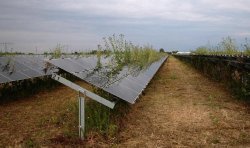RB
Established Member
- Joined
- Nov 17, 2004
- Posts
- 4,312
The problem is that best production in January will realistically be over 8 hours and in winter might only be 4 hours for my NE roof, but my consumption would be over 24 hours. So 16 or more of those hours I will only reduce the electricity hourly price by the net feed in tariff.
Beer coaster calculations for a net 15kW array:
Summer @ 90kW/day @91 days = 8190kW
Winter @ 45kW/day @91days = 4095kW
Spring and autums @ 67kW/day@ 183 days = 12261kW
Total generation less 10% for cloudy days = 22000 kW
$20000 at 5% interest for 10 years paid quarterly (to match with electric billing) = $638.
Annual = $2552
Cost of electricity generation by solar array = 11.5c/kwh. (2552/22000)
Net feed in tariff in my area = 12.5c/kWh
Effectively the net feed in tariff is normalised cost of electricity generation by solar.
So costing me 11.5c to pump excess electricity into grid and energy retailer pays me 12.5c (but only if electricity usage is greater than feed in)
Go big and the benefit is 1c/kWh.
So putting more panels to improve the cost efficiency of inverter may not be so cost effective. Maybe better to go with smaller inverter.
At best solar on a NE roof for me would ensure 100% cover of the 8am-2pm electricity consumption and maybe an hour or two into the peak 2pm-8pm in January. The rest of the electricity would be a feed into the grid to offset any use for the 1400-0800 hrs period by 12.5c/kWh
Alternatively why not just have enough to cover consumption and not have any feed in to the Grid
Problem is a lot of solar calculations do not include the amortised sunk capital cost of the Array nor the opportunity cost of the capital and only look at the savings at the other end.
Solar panels are a depreciating asset so the capital cost cannot be retrieved.
However the cost of solar generation will remain fixed at 11.5c/kWh while electricity prices are only set to rise in spite of what Fraudenberg wants us to believe with his NEG.
Battery??
Telsa 2 = $12000 installed
Tesla gives a warranted amount of kWh at 38000kWh (about 7-9 years depends on premises)
$12000 at 7 years 5% quarterly = $511 per quarter = $2044 per year
Total cost plus interest over 7 years = $14300
However industry figures suggest net efficiency with Tesla 2 reduces by further 10% on top of normal losses
on a warranted per kwh basis = 14300/34200 = 41.8c/kWh
So each kWh Tesla 2 outputs will cost 41.8c/kWh
Hardly inspiring
From this and other posts of yours, am I correct in assuming you are on a time of use tariff?-I think many people are not.
I understood the ballpark for Sydney is 3.9kw/h per 1kw system where Brisbane is 4.2, Melb 3.6, Adelaide 4.2.
I agree with your assertion that opportunity costs rarely seems to get considered.
















